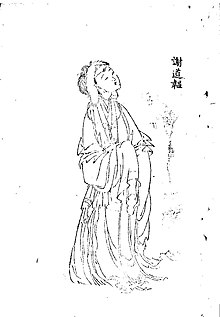| Xie Daoyun | |
|---|---|
 1772 drawing of Xie Daoyun. 1772 drawing of Xie Daoyun. | |
| Spouse | Wang Yinzhi (王凝之) |
| Parent | Xie Yi (謝奕) |
| Relatives | Wang Xizhi (father-in-law) Xie Xuan (brother) Xie An (uncle) |
Xie Daoyun (謝道韞, before 340–after 399) was a Chinese poet, writer, scholar, calligrapher, and debater of the Eastern Jin Dynasty.
Family
Born in Yangxia County, Henan, Daoyun belonged to the Xie clan of Chen Commandery and was a sister of the general Xie Xuan. Though her mother is unknown, it is known that she gave birth to five more children. She was also the favorite niece of Prime Minister Xie An. There were Daoist and Confucianist influences in her work.
Life
Her uncle Xie An enjoyed spending time with his nieces and nephews and would quiz them on literature and philosophy. She outperformed her siblings and cousins during the tests her uncle set. Later, she would defend her uncle against the criticism of Huan Xuan.
She married Wang Ningzhi, son of the famous calligrapher Wang Xizhi of the Wang clan of Langya. Despite being displeased with him, they still had several children together. The Wang family had debates at their house and she was undefeated at those.
Xie Daoyun and her children accompanied Wang Ningzhi to Jiangzhou, when he became a regional inspector. When Sun En led a rebellion, Xie Daoyun tried to warn her husband to raise recruits for defense but is rebuffed, so she gathered and train servants and maids everyday. Due to mismanagement, Wang and their sons were killed by rebels. Xie Daoyun and her maids then went to meet the rebels. She is said to have killed several before being taken prisoner. When the rebel leader Sun En planned to kill her grandson as well, she told him to kill her first. After this, he spared the boy's life.
Xie Daoyun returned to Kuaiji and lived out her days in the Wang household.
Legacy
The Book of Jin has a detailed biography of her. This book states that her work was popular with her contemporaries. She was seen as a symbol of female talent during her time and during later dynasties. The Three Character Classic tells her story and a Ming Dynasty musical composition is all about the gatherings of Xie Daoyun and Xie An.
References
- Xiong (2017), p. 699.
- Lily Xiao Hong Lee; A. D. Stefanowska. Biographical dictionary. p. 360.
- Lily Xiao Hong Lee; A. D. Stefanowska. Biographical dictionary. p. 361.
- Lily Xiao Hong Lee Zheng; A. D. Stefanowska. Biographical dictionary. p. 363.
Bibliography
- Lily Xiao Hong Lee; A. D. Stefanowska (2007). Biographical dictionary of Chinese women: antiquity through Sui, 1600 B.C.E.-618 C.E. M.E. Sharpe, Inc.
- Xiong, Victor Cunrui (2017). Historical Dictionary of Medieval China (2nd ed.). Lanham, Maryland; New York City; London: Rowman & Littlefield.
| Chinese poetry | |
|---|---|
| Major eras | |
| Poetry by dynasty | |
| Poetry works and collections | |
| Major forms | |
| Individual poems list | |
| Modern compilations | |
| Regional styles | |
- Chinese women philosophers
- Women in war in China
- Women in ancient Chinese warfare
- 4th-century Chinese women
- 4th-century Chinese people
- 4th-century Chinese women writers
- 4th-century Chinese writers
- 4th-century Chinese philosophers
- Women in 4th-century warfare
- Jin dynasty (266–420) philosophers
- Jin dynasty (266–420) writers